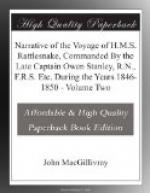(Footnote. Resembling that figured in Jukes’ Voyage of the Fly volume 1 page 277, but smaller.)
NATIVE HAIR-DRESSING.
The greatest peculiarity among these people is their mode of dressing the hair; it is usually shaved off the temples and occasionally a little way up the forehead, then combed out at length, and tied midway with a string, leaving one part straight, and the remainder frizzled out into a mop projecting horizontally backwards. Some also had a long pigtail hanging down behind, in one case decorated with a bunch of dogs’ teeth at the end. Across the forehead they wore fillets of small shells strung together over a broad white band of some leafy substance. The septum of the nose was perforated, and some wore a long straight nose-stick of bone with black bands. All our visitors had their teeth darkened with the practice of betel chewing—we saw them use the leaf of the betel pepper, the green areca nut, and lime, the last carried in a small calabash with a spatula.
LEAVE NEW GUINEA.
We had been becalmed all the morning, but before noon the seabreeze set in from the South-South-East, and we got underweigh, ran past South-west Cape, and anchored in 22 fathoms mud, off a large island afterwards named in honour of Lieutenant Yule.
September 27th.
This has proved a very uneasy anchorage under the combined influence of a strong breeze from the south-east and a heavy sea. At one P.M. we got underweigh in company with the Bramble, and left the coast of New Guinea, running to the westward for Cape York, in order to meet the vessel with our supplies from Sydney.
Next evening Bramble Cay was seen on our weather beam; being so low and so small an object, we had nearly missed it. We hauled upon a wind immediately but could not fetch its lee, so anchored two and a half miles North-west by West from it. Great numbers of boobies and noddies came about us, but our distance from the shore was too great and our stay too short to send on shore for birds’ eggs.
September 29th.
With a strong south-easterly breeze we passed to the westward of Campbell and Stephens Islands, the Bramble leading, and anchored in the evening near Marsden Island. On Campbell Island, numbers of the natives came down to the edge of the reef, waving to us as we passed by, and inviting us to land. There were many coconut-trees, and we saw a village on the north-west side of the island, beautifully situated on the shady skirts of the wood. The huts resemble those of Darnley Island, being shaped like a haycock or beehive, with a projecting central pole ornamented with a large shell or two attached to it. Most of the huts were situated in small enclosures, and there were other portions of ground fenced in with tall bamboo paling.
On the following day the Bramble* left us for Booby Island, to call at the post office there, and rejoin company at Cape York, and we reached as far as the neighbourhood of Coconut Island at noon, passing close to Arden Island, then covered with prodigious numbers of blue and white herons, small terns, curlews, and other waders.




